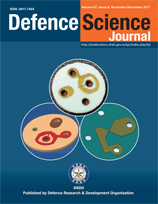Alpha-2-Antiplasmin : A Fibrinolytic Peptide, could be a Potential Biomarker for Diagnosis of High Altitude Induced Pulmonary Hypertension
DOI:
https://doi.org/10.14429/dsj.67.11694Keywords:
High altitude, Pulmonary hypertension, Alpha-2-antiplasmin, FibrinolysisAbstract
Prolonged exposure to high altitude is known to cause pulmonary vascular remodeling and pulmonary hypertension. Despite the advancements in diagnostics of pulmonary hypertension (PH), a potential biomarker for early diagnosis of PH progression is still lacking. High altitude induced pulmonary hypertension (HAPH) is great concern in mountain regions across the world. Early diagnosis and monitoring the disease progression are critical for therapeutic decisions. A fibrinolytic peptide, alpha-2-antiplasmin (α2AP) is known to cause tissue and vascular remodeling. Recently, elevated levels of α2AP were reported in different forms of PH; however its role in high altitude induced pulmonary hypertension is not yet known. To assess whether α-2AP can be used as diagnostic marker for HAPH, a cross sectional study was carried out on 100 healthy male Indian army soldiers who were posted to high altitude (14,800 ft to 18,700 ft) for a prolonged period of 6 to 8 months. We used 2D Echocardiography to screen the pulmonary arterial systolic pressure (PASP) and semi-quantitatively ELISA method for estimation of α-2AP in plasma. We found 34 out of 100 subjects have elevated PASP upon immediate screening after de-induction to moderate altitude of 10,000 ft. Age matched 17 subjects with elevated PASP were assessed for plasma levels of α-2AP in comparison to subjects with normal PASP, but posted to same altitude for same duration of time. Here for the first time we demonstrated an increase in plasma level of α-2AP was positively correlated with hypoxia induced elevated pulmonary arterial pressure. However, additional comprehensive investigations are warranted with large sample size to confirm our findings and explore the use of α2AP as potential diagnostic marker for monitoring progression of HAPH.
Downloads
Published
How to Cite
Issue
Section
License
 Where otherwise noted, the Articles on this site are licensed under Creative Commons License: CC Attribution-Noncommercial-No Derivative Works 2.5 India
Where otherwise noted, the Articles on this site are licensed under Creative Commons License: CC Attribution-Noncommercial-No Derivative Works 2.5 India


